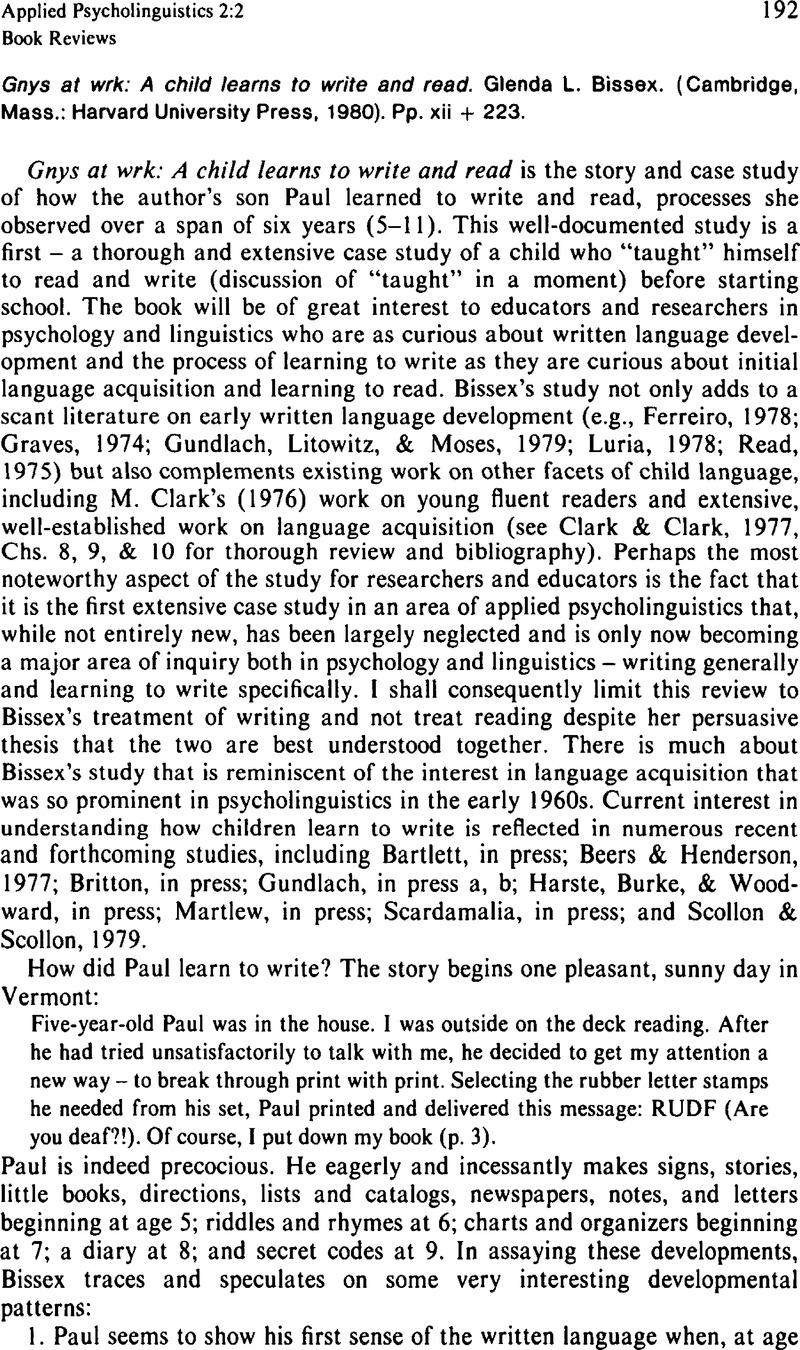No CrossRef data available.
Article contents
Gnys at wrk: A child learns to write and read. Glenda L. Bissex. (Cambridge, Mass.: Harvard University Press, 1980). Pp. xii + 223.
Published online by Cambridge University Press: 28 November 2008
Abstract
An abstract is not available for this content so a preview has been provided. Please use the Get access link above for information on how to access this content.

- Type
- Book Reviews
- Information
- Copyright
- Copyright © Cambridge University Press 1981
References
REFERENCES
Bartlett, E.Learning to write: Some cognitive and linguistic components. New York: The Ford Foundation, in press.Google Scholar
Beers, J. W., & Henderson, E. H.A study of developing orthographic concepts among first graders. Research in the Teaching of English, 1977, 11, 133–148.Google Scholar
Britton, J. Spectator role and learning to write. In Nystrand, M. (Ed.), What writers know: The language, process, and structure of written discourse. New York: Academic Press, in press.Google Scholar
Clark, H. H., & Clark, E. V.Psychology and language: An introduction to psycholinguistics. New York: Harcourt, Brace, Jovanovich, 1977.Google Scholar
Ferreiro, E.What is written in a written sentence? A developmental answer. Journal of Education, 1978, 160, 25–39.Google Scholar
Graves, D.Children’s writing: Research directions and hypotheses based upon an examination of the writing processes of seven-year-old children. Ann Arbor: University Microfilms, 1974, No. 7408375.Google Scholar
Gundlach, R. A., Litowitz, B. E., & Moses, R. A. The ontogenesis of the writer’s sense of audience: Rhetorical theory and children’s written discourse. In Brown, R. & Steinmann, M. Jr., (Eds.), Rhetoric 78: Proceedings of theory of rhetoric: An interdisciplinary conference. Minneapolis: University of Minnesota Center for Advanced Studies in Language, Style, and Literary Theory, 1979.Google Scholar
Gundlach, R. A., Litowitz, B. E., & Moses, R. A. On the nature and development of children’s writing. In Frederiksen, C., Whiteman, M., & Dominic, J. (Eds.), Writing: The nature, development, and teaching of written communication. Hillsdale, N.J.: Lawrence Erlbaum Associates, in press a.Google Scholar
Gundlach, R. A., Litowitz, B. E., & Moses, R. A. Children as writers: The beginnings of learning to write. In Nystrand, M. (Ed.), What writers know: The language, process, and structure of written discourse. New York: Academic Press, in press b.Google Scholar
Halliday, M. A. K.Language as social semiotic: The social interpretation of language and meaning. Baltimore: University Park Press, 1978.Google Scholar
Harste, J., Burke, C., & Woodward, V. Children’s language and the world: Initial encounters with print. In Langer, J. & Smith-Burke, M. (Eds.), Bridging the gap: Reader meets author. Newark, Del.: International Reading Association, in press.Google Scholar
Jakobson, R.Child language, aphasia, and phonological universals. The Hague: Mouton, 1968.Google Scholar
Luria, A. R. The development of writing in the child. In Cole, M. (Ed.), Selected writings of A. R. Luria. White Plains, N.Y.: M. E. Sharpe, 1978.Google Scholar
Martlew, M. (Ed.). The psychology of written language: A developmental approach. London: John Wiley & Sons, in press.Google Scholar
Read, C. The preschool orthographers. In Lenneberg, E. & Lenneberg, E. (Eds.), Foundations in language development: A multidisciplinary approach. 2 vols. New York: Academic Press, 1975.Google Scholar
Scardamalia, M. How children cope with the cognitive demands of writing. In Frederiksen, C., Whiteman, M. F., & Dominic, J. F. (Eds.), Writing: The nature, development and teaching of written communication. Hillsdale, N.J.: Lawrence Erlbaum Associates, in press.Google Scholar
Scollon, R., & Scollon, S. The literate two-year-old: The fictionalization of self. Working papers in sociolinguistics. Austin, Tex: Southwest Regional Laboratory, 1979.Google Scholar
Stubbs, M.Language and literacy: The sociolinguistics of reading and writing. London: Routledge & Kegan Paul, 1980.Google Scholar
Stubbs, M. Written language and society: Some particular cases and general observations. In Nystrand, M. (Ed.). What writers know: The language, process, and structure of written discourse. New York: Academic Press, in press.Google Scholar
Vygotsky, L. S. [Thought and language] Hanfman, E. and Vakar, G. (Eds. & trans.) Cambridge, Mass: M.I.T. Press, 1962.Google Scholar
Werner, H.Comparative psychology of mental development. New York: Science Editions, 1948.Google Scholar




